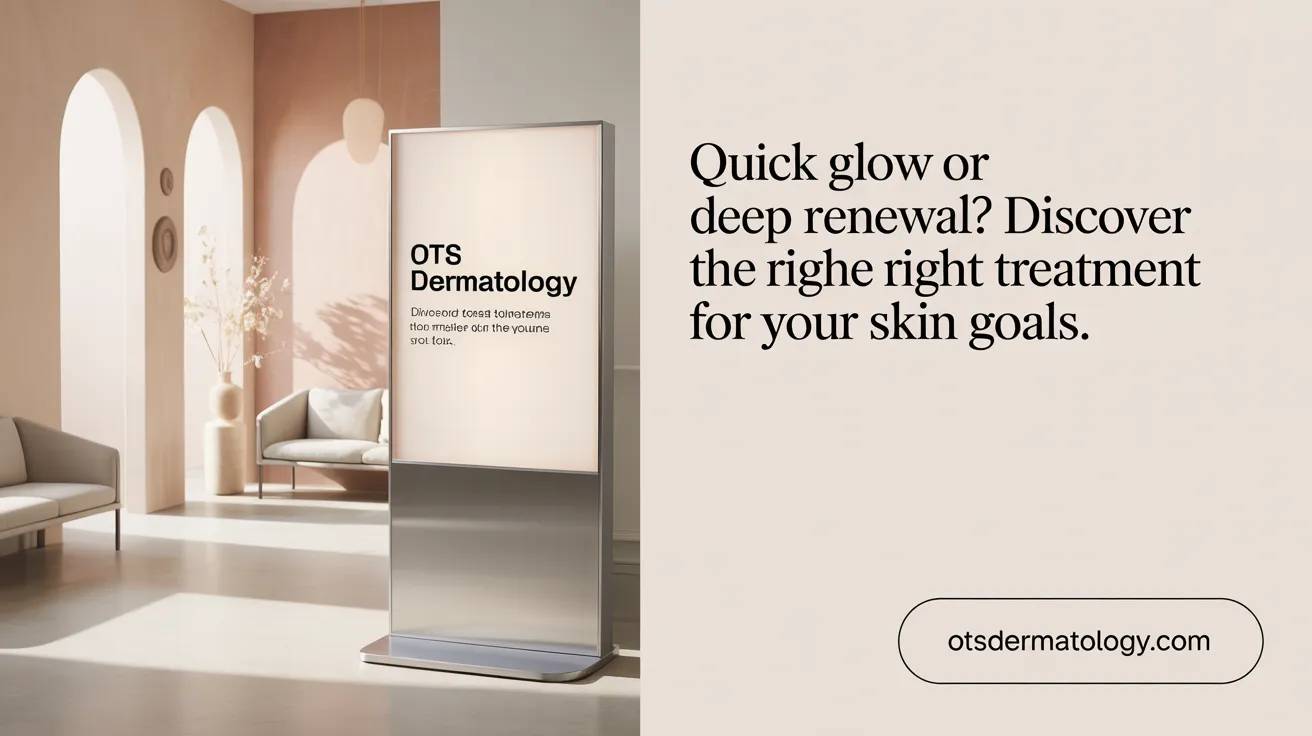Understanding Hydrafacial, Microneedling, and Chemical Peels
General Overview of Each Treatment
Hydrafacial is a non-invasive, multistep facial treatment that cleanses, exfoliates, extracts impurities, and infuses the skin with tailored serums to hydrate and refresh the complexion. Microneedling uses tiny needles to create micro-injuries in the skin, stimulating collagen and elastin production, which improves skin texture, reduces scars, fine lines, and wrinkles over time. Chemical peels involve applying acid solutions to exfoliate the skin's surface layers, promoting cell turnover and addressing issues like uneven tone, age spots, and wrinkles.
Basic Mechanisms and Benefits
Hydrafacial uses hydradermabrasion technology with a spiral exfoliating tip and suction to remove dead skin cells and deliver moisturizing serums, providing immediate visible improvements with no downtime. Microneedling mechanically induces collagen remodeling through controlled punctures, leading to gradual, long-lasting improvements in skin firmness and scar appearance. Chemical peels chemically dissolve the outer skin layers to renew the skin’s surface, improving texture and clarity, with recovery dependent on the peel depth.
Suitability for Skin Types
Hydrafacials are suitable for all skin types, including sensitive and acne-prone skin, offering a gentle yet effective treatment with minimal risks. Microneedling is safe for most skin tones when performed by a board-certified dermatologist but is generally avoided in cases of active acne or poor healing. Chemical peels can be customized by depth for different skin types, but deeper peels require careful consideration for conditions like rosacea or eczema to avoid complications.
Key Facts on Hydrafacial, Microneedling, and Chemical Peels
- Hydrafacial is a non-invasive treatment that provides immediate hydration and radiance with minimal downtime.
- Microneedling uses tiny needles to create controlled micro-injuries, stimulating collagen and elastin production over several weeks.
- Hydrafacial is gentle and safe for sensitive skin, making it ideal for rosacea, eczema, or acne-prone conditions.
- Microneedling typically involves 3-5 sessions, spaced several weeks apart, with gradual results appearing over months.
- Chemical peels can be superficial, medium, or deep, with recovery time increasing with depth; deeper peels require longer downtime.
- Microneedling causes mild redness lasting a few days, whereas chemical peels' recovery varies from minimal to weeks based on peel depth.
- Hydrafacial costs approximately $175 to $300 per session, requiring single quick treatments; microneedling ranges from $300 to $600 per session with more intensive procedures.
- Chemical peels involve acid exfoliation to promote cell turnover and can be repeated based on peel depth, with annual or more frequent treatments recommended.
- Both treatments require professional assessment for personalized protocols, pre-treatment care, and diligent post-treatment sun protection.
- In Glenview, Illinois, clinics offer personalized skincare treatments including hydrafacial, microneedling, and chemical peels for optimal skin health.
1. Hydrafacial vs. Microneedling: Immediate Glow Versus Lasting Texture Improvement

How do Hydrafacial and microneedling differ in their approach and effects?
Hydrafacial is a non-invasive skin treatment that combines multiple steps: cleansing, exfoliation, extraction of impurities, and infusion of customizable serums. It uses hydradermabrasion technology to deliver immediate hydration and radiance, with results visible right after the session. This treatment effectively improves skin tone, reduces fine lines, unclogs pores, and smooths skin texture. It is suitable for all skin types, including sensitive and acne-prone skin.
In contrast, microneedling uses a device equipped with tiny needles to create controlled micro-injuries in skin. These small punctures stimulate the body’s natural healing response, promoting collagen and elastin production. The benefits include gradual improvement of acne scars, fine lines, wrinkles, pore size, and overall skin texture. Unlike Hydrafacial, the visible effects develop over several weeks to months, requiring a series of treatments for optimal results.
What are the downtime and recovery differences between the two?
Hydrafacial is known for its minimal to zero downtime. Most patients can resume daily activities immediately after the procedure without signs of redness or irritation. This makes it an excellent choice for individuals with busy schedules or those wanting a quick refresher before events.
Microneedling, being a minimally invasive procedure, typically involves a short recovery period. Patients may experience mild redness, swelling, or a sunburn-like sensation lasting from one to three days. Because the treatment encourages collagen remodeling, results are more gradual, and multiple sessions spaced weeks apart are recommended to achieve significant improvement.
Which treatment is better for sensitive or reactive skin?
For sensitive or reactive skin types, Hydrafacial is often the preferred option due to its gentle exfoliation and hydration steps that minimize irritation. It is safe and soothing for skin affected by conditions like rosacea, eczema, or acne.
While microneedling is generally safe when performed by experienced dermatologists, it is not recommended for those with active pustular acne or uncontrolled eczema, as the micro-injuries may aggravate inflammation. For these patients, Hydrafacial provides an effective and comfortable alternative.
Additional considerations: Treatment sessions, results timeline, and cost
Hydrafacial typically consists of single 30-minute sessions providing immediate results. Many patients choose to have treatments monthly or before special occasions to maintain a youthful glow.
Microneedling generally requires 3 to 5 sessions spaced approximately 4 to 6 weeks apart to see cumulative effects. The full benefits emerge gradually as collagen production increases over time.
In terms of costs, Hydrafacial sessions range from approximately $175 to $300, reflecting its quick, non-invasive nature. Microneedling is usually priced between $300 and $600 per session due to its more intensive treatment and longer-lasting effects.
Local dermatology clinics in Glenview, Illinois offer both treatments with personalized options to suit individual skin goals and conditions, ensuring professional care and optimal skin health outcomes.
2. Microneedling Versus Chemical Peels: Collagen Stimulation Meets Controlled Exfoliation

How do microneedling and chemical peels differ in their skin treatment approaches?
Microneedling involves the use of tiny needles to create controlled micro-injuries in skin, which stimulates the body’s natural production of collagen and elastin. This process effectively targets acne scars, fine lines, wrinkles, discoloration, and irregular skin texture. The results from microneedling appear gradually over several weeks to months, often requiring multiple sessions for optimal improvement. Learn more about the Microneedling benefits and Microneedling for acne scars.
Chemical peels, in contrast, use acid-based solutions to exfoliate the skin by removing dead or damaged outer layers. The depth of chemical peels can be superficial, medium, or deep, depending on the strength and type of acids used. This exfoliation promotes cell turnover and collagen formation and is suitable for treating fine lines, wrinkles, age spots, acne scars, and even precancerous skin conditions. The different depths influence both efficacy and recovery time. For detailed information, see Chemical peels overview and Chemical peel benefits.
What are the differences in recovery and side effects?
Microneedling typically causes mild redness and swelling that lasts for a few days, with minimal downtime allowing patients to resume normal activities quickly. Side effects are rare but may include temporary skin irritation or very mild discoloration. Read up on microneedling downtime and side effects and microneedling contraindications.
Chemical peels’ recovery varies significantly based on the depth performed. Superficial peels usually allow for minimal downtime with mild redness and peeling. Medium to deep peels require longer recovery periods, ranging from several days to weeks, often involving redness, peeling, and increased skin sensitivity. Both treatments carry some risk of post-inflammatory hyperpigmentation, especially for patients with darker skin tones. Proper sun protection and adherence to post-treatment care are essential to minimize risks. More about chemical peel recovery and chemical peel post-care instructions is available.
How do treatment plans differ?
For microneedling, a typical plan includes 3 to 5 sessions spaced several weeks apart, with annual maintenance treatments recommended to sustain collagen stimulation and skin rejuvenation. Find details on optimal microneedling sessions and microneedling session duration.
Chemical peels are administered based on their type and depth: light peels can be repeated every 1 to 4 weeks for gradual improvement; medium peels are often repeated every 6 to 12 months; deep peels are usually performed as a single, more intensive procedure with longer recovery. Both treatment types benefit greatly from personalized evaluation and customization by dermatology professionals, ensuring tailored protocols according to skin type, color, and specific concerns. For more on chemical peel frequency and personalized skin care at dermatology centers, refer to these resources.
Customization and professional oversight
Both microneedling and chemical peels require professional guidance to achieve the best results safely. Dermatologists assess individual skin conditions and optimize treatment depth and frequency accordingly. Pre-treatment care may involve avoiding certain medications or sun exposure, while post-treatment care focuses on moisturization, healing, and diligent sun protection. Explore professional skin care guidance and chemical peel pre-treatment guidelines.
In Glenview, Illinois, dermatology centers offer expert services to customize microneedling and chemical peel treatments, integrating advanced techniques and personalized care for enhanced outcomes and minimized risks. Learn more about dermatology services in Glenview at Glenview Dermatology Office Location and Dermatologist in Glenview IL.
3. Hydrafacial Versus Chemical Peels: Non-Invasive Glow Versus Intense Skin Renewal

What distinguishes Hydrafacial treatments from chemical peels?
Hydrafacials provide a gentle, multi-step hydradermabrasion experience that combines cleansing, exfoliation, extraction, and infusion of customized serums. This approach is suitable for all skin types, including sensitive skin, delivering immediate hydration and a radiant glow. The treatment is designed to allow quick resumption of daily activities, with virtually no downtime.
Chemical peels use acid-based solutions to remove layers of the skin, promoting cell regeneration. The intensity varies with the chemical peel depths (superficial, medium, deep) — from light peeling of the outer skin to deeper treatments targeting wrinkles, pigmentation, and other significant concerns. Deeper peels require longer recovery periods and careful preparation and aftercare.
Which is better for quick skin rejuvenation or special occasions?
Hydrafacial stands out for providing instant skin refreshment. Typically lasting about 30 minutes, it requires no downtime, making it an excellent choice for those preparing for special events or seeking a quick glow.
Chemical peels, particularly medium and deep varieties, necessitate careful scheduling due to their associated downtime and recovery. This makes them less suitable for immediate pre-event treatments.
How do professional clinics customize these treatments?
Dermatology clinics, including those in Glenview, Illinois, offer personalized treatment plans. Hydrafacials can be enhanced with options such as LED light therapy, lymphatic drainage, or dermaplaning tailored to individual skin needs.
For chemical peels, experts select the peel’s strength and type based on the patient’s skin condition and goals. Pre- and post-treatment care instructions are vital to minimize risks such as pigmentation changes and optimize results.
Both treatments emphasize safety and customization, ensuring patients receive care best suited to their skin health and aesthetic objectives.
Choosing the Right Treatment for Your Skin Needs
Understanding Your Options
When selecting between microneedling and HydraFacial treatments, it’s important to understand the unique benefits of each. Microneedling is known for its ability to boost collagen and elastin production, targeting issues like acne scars, fine lines, and uneven skin texture. It provides long-term improvements but requires several sessions and some recovery time.
HydraFacial offers gentle exfoliation, deep cleansing, and hydration using customized serums. This treatment provides immediate results, enhancing skin radiance and texture with virtually no downtime, making it ideal for all skin types, including sensitive skin.
Matching Treatment to Skin Type and Conditions
Microneedling is particularly effective for individuals dealing with scarring, wrinkles, and volume loss but may not suit those with active acne or sensitive skin prone to irritation. Conversely, HydraFacial is a versatile choice that suits most skin tones and conditions, including rosacea and eczema, focusing on hydration and pore cleanliness.
The Value of Personalized Dermatology Care
Professional assessment and customized treatment plans by board-certified dermatologists or experienced aestheticians are essential. Personalized care ensures treatments are appropriate to your skin’s needs, minimizing risks and maximizing benefits.
Combining Treatments for Enhanced Results
Some clinics in Glenview, Illinois, offer combination protocols, where HydraFacial treatments are paired with microneedling to provide both immediate glow and deeper skin remodeling. This personalized approach can optimize skin rejuvenation by leveraging the strengths of both treatments.
